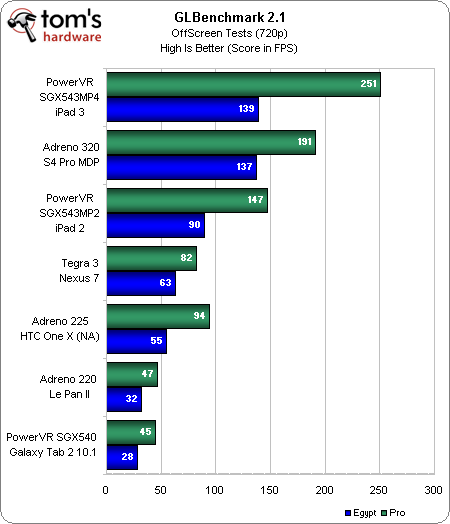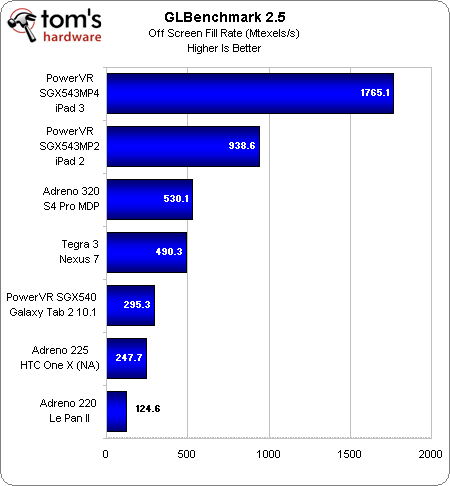Snapdragon S4 Pro: Krait And Adreno 320, Benchmarked
Graphics Performance: Adreno 320 Under GLBenchmark 2.1 And 2.5
Fortunately, it's easier for us to evaluate graphics performance. Let's start by running off-screen tests using GLBenchmark 2.1.
Our benchmark results tell it all. The SGX543MP4 in Apple's iPad 3 is the performance king at 1280x720. Qualcomm's Adreno 320 nearly matches Imagination Technologies' work in the Egypt test, but falls short by roughly 30% in the Pro benchmark.
The effective fill rate of the PowerVR GPUs is good, and that's a big advantage for Imagination Technologies, since mobile game developers tell us that fill rate is a primary bottleneck in their work.
Although Adreno 320 is routed by the SGX543MP, Qualcomm still deserves recognition for improving its graphics architecture. The Adreno 320 serves up three to four times as many frames per second as Adreno 220, and its fill rate is more than six times higher.
Over time, today's most prolific resolutions will evolve into higher-def screens. We've already seen Apple's third-gen iPad 3 enable 2048x1536, necessitating more powerful graphics hardware in the process. Clearly, it'll become increasingly important to benchmark mobile graphics architectures under more demanding circumstances. Today, the best we can do is Kishonti's latest GLBenchmark 2.5, which continues to primarily test OpenGL ES 2.0 features, but now specifically targets 1920x1080 and higher-quality textures.
Under the duress of what GLBenchmark 2.5 applies to each graphics subsystem, the results change. Qualcomm's Adreno 320 emerges victorious over Imagination's SGX543MP4. The margin is really pretty small, and the Pro test that favored PowerVR graphics previously is no longer part of the benchmark. So, the swap isn't quite decisive. But it's at least interesting to see Adreno maintain more of its frame rate in this more taxing workload.
Unfortunately, Qualcomm can't achieve the fill rate of Imagination's tile-based deferred renderer. The Adreno 320 does, however, improve greatly on last-generation's Adreno 220 implementation.
Get Tom's Hardware's best news and in-depth reviews, straight to your inbox.
Current page: Graphics Performance: Adreno 320 Under GLBenchmark 2.1 And 2.5
Prev Page Nitty Gritty: CPU Core Performance, Per Clock Next Page S4 Pro Puts Qualcomm Back In The Fight-
shotgunz Naw, more like give foxconn workers better salary, do something good with mountain of money they have, stop patent trolling, stop silly war with google/samsung and stop lieing. Then maybe Apple will be forgiven.Reply -
luciferano shotgunzNaw, more like give foxconn workers better salary, do something good with mountain of money they have, stop patent trolling, stop silly war with google/samsung and stop lieing. Then maybe Apple will be forgiven.Reply
Well, it'd be a start. I wouldn't go nearly as far as all is forgiven. -
mayankleoboy1 AFAIUI, the PowerVR GPU in ipad3 is more of a brute force architecture. "Just throw more transistors" is its mantra. So its good in current workloads.Reply
The Adreno320 is more refined and optimised arch. Trying to get the most performance from least silicon area. It is still being refined. Hence, it will do well in future applications. -
Why the ST-ericsson 8500 isn't in this list either? too few phone out? Xperia S/P... looks it would rock some of concurrents.. omap..S3...Reply
Please be as exaustive as possible ;) -
Error in the chart on second page.Reply
The cortex A15 DMIPS/MHz should read above the A9. Around 3.5 DMIPS/MHz from the rumblings. -
These krait numbers aren't very impressive if you normalize for clockspeeds.Reply
In fact, they seem to suggest only a very small improvement over A9, if any at all.





